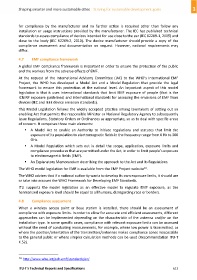Page 623 - Shaping smarter and more sustainable cities - Striving for sustainable development goals
P. 623
for compliance by the manufacturer and no further action is required other than follow any
installation or usage instructions provided by the manufacturer. The IEC has published technical
standards to assess compliance of devices intended for use close to the ear (IEC 62209‐1, 2005) and
close to the body (IEC 62209‐2, 2010). The device manufacturer should provide a copy of the
compliance assessment and documentation on request. However, national requirements may
differ.
4.7 EMF compliance framework
A global EMF compliance framework is important in order to ensure the protection of the public
and the workers from the adverse effects of EMF.
At the request of the International Advisory Committee (IAC) to the WHO’s International EMF
Project, the WHO has developed a Model Act and a Model Regulation that provide the legal
framework to ensure this protection at the national level. An important aspect of this model
legislation is that it uses international standards that limit EMF exposure of people (that is the
ICNIRP exposure guidelines) and international standards for assessing the emissions of EMF from
devices (IEC and IEEE device emission standards).
This Model Legislation follows the widely accepted practice among lawmakers of setting out an
enabling Act that permits the responsible Minister or National Regulatory Agency to subsequently
issue Regulations, Statutory Orders or Ordinances as appropriate, so as to deal with specific areas
of concern. It comprises three main elements:
A Model Act to enable an Authority to initiate regulations and statutes that limit the
exposure of its population to electromagnetic fields in the frequency range from 0 Hz to 300
GHz.
A Model Regulation which sets out in detail the scope, application, exposure limits and
compliance procedures that are permitted under the Act, in order to limit people’s exposure
to electromagnetic fields (EMF).
An Explanatory Memorandum describing the approach to the Act and its Regulations.
14
The WHO model legislation for EMF is available from the EMF Project website .
The WHO advises that if a national authority wants to develop its own exposure limits, it should use
or take into account the WHO Framework for Developing EMF Standards.
ITU supports the model legislation as an effective model to regulate EMF exposure, as the
harmonized exposure level should be equal to all humans, disregarding race or borders.
4.8 Compliance assessment
When a wireless access point or base station is installed, there should be an assessment of
compliance with exposure limits. In order to allow for accurate and efficient assessments, different
approaches can be implemented depending on the characteristic of the antenna and/or on the
installation type. In some specific cases, compliance with relevant exposure limits can be assessed
without the need of conducting measurements, for example, where low power is transmitted, or
where the position/orientation of the transmitters/antennas makes compliance zones inaccessible
to the general public or where simpler calculation methods can be used (Recommendation ITU‐T
K.52).
____________________
14 http://www.who.int/peh‐emf/standards/en/
ITU‐T's Technical Reports and Specifications 613

